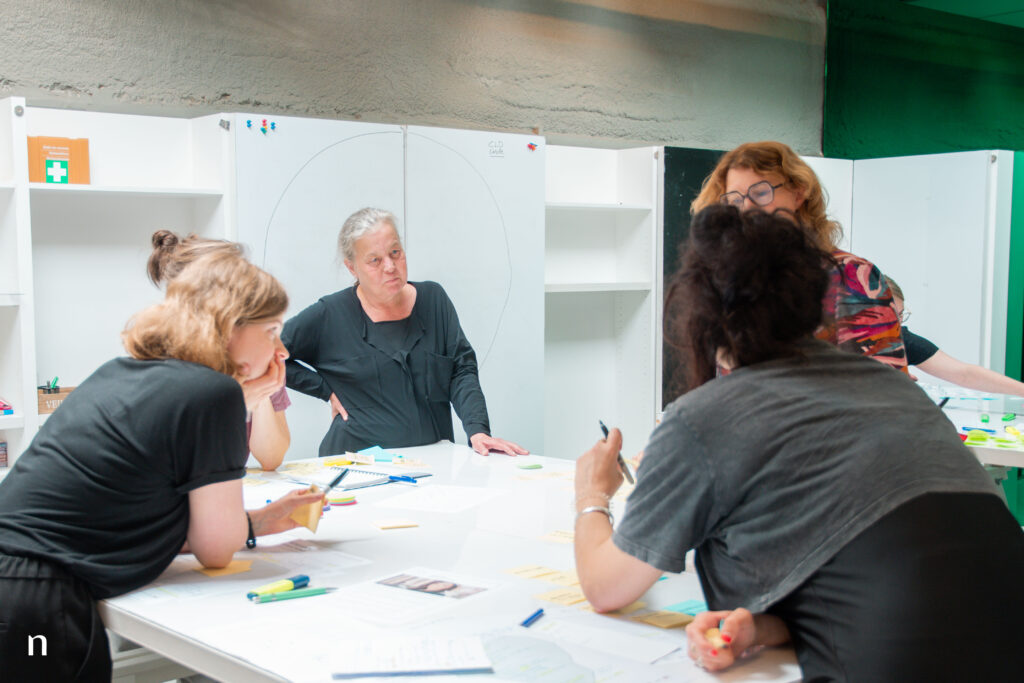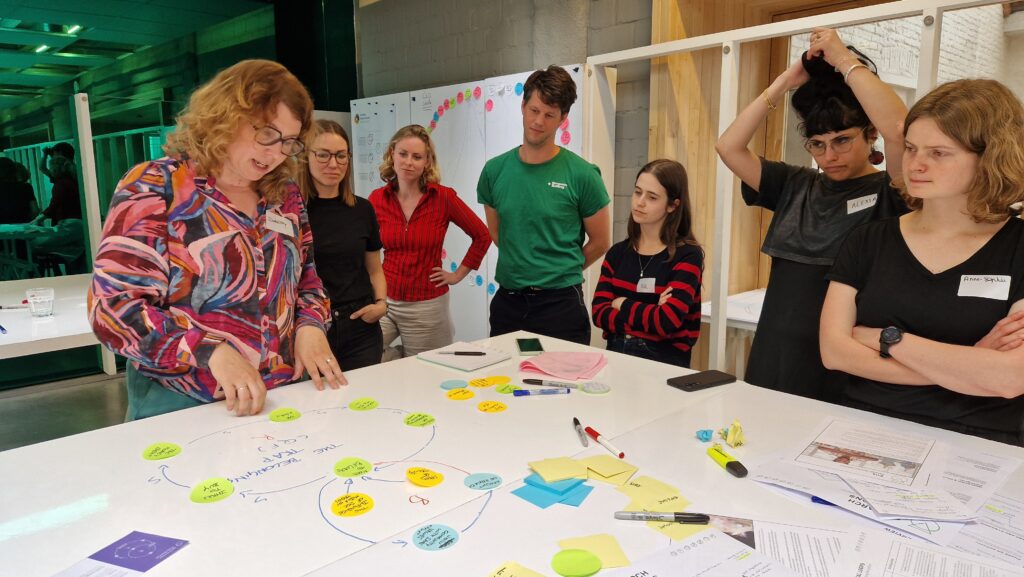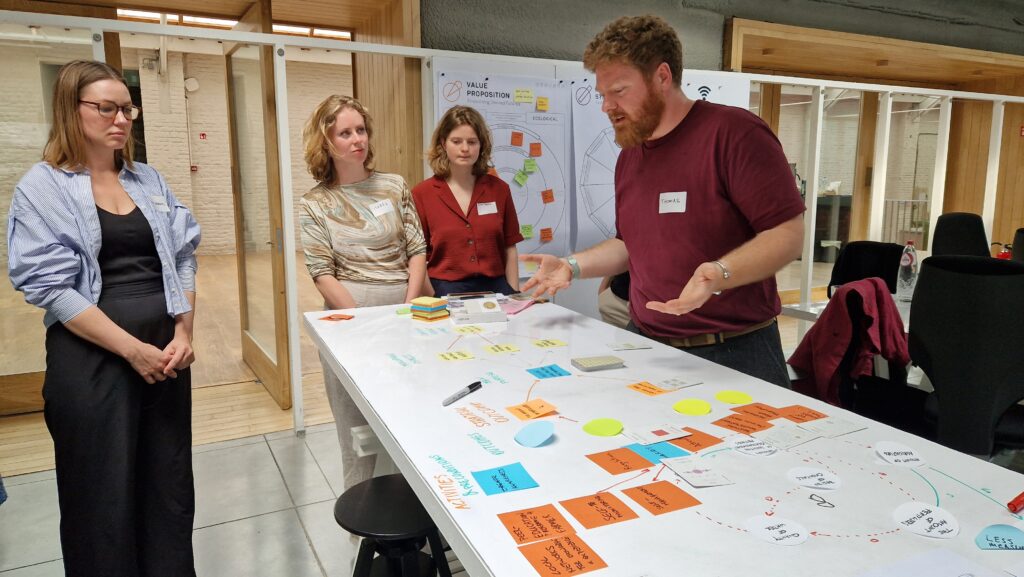
Systemic Design
TRAINING
Master the tools of the innovative toolkit co-created by Namahn designers in our two-day training course on Systemic Design.
| Price | Date | location |
|---|---|---|
| 1.500€ – excl. VAT | Tu.-We., April 22-23, 2025. (Next date in autumn to be announced) | Namahn Design Studio (Brussels) |




Systemic design combines concepts of systems thinking and design thinking. It helps you zoom out and look at the whole problem. Systemic design brings a set of solutions or, better, “interventions” that can reinforce each other to drive a change in a current problematic situation.
For more information, visit the website about the Systemic Design Toolkit or have a look at the book on systemic design that Kristel Van Ael and Peter Jones have published: Design Journeys Through Complex Systems.
Wonderful overview of the systemic design methodology! It cleared out my confusion at sticking together the tools, that I had beforehand from learning only by reading the book.
Researcher at the University of Surrey, 2024
What to expect
Day 1
The first day begins with an introduction to systemic design and the 7 stages of the Namahn systemic design methodology. Next, participants will focus on:
- Listening to the system: You will learn how to conduct interviews using a systemic perspective. This involves identifying and analyzing contributing factors within the system, using contextual interview techniques. The session will introduce the four layers of Causal Layered Analysis (CLA) to prepare for and conduct effective interviews.
- Understanding the system: After gathering data through interviews, participants will create system maps. You will be introduced to various mapping techniques, with a focus on crafting Causal Loop Diagrams (CLD). The session includes practical guidance on listing variables, identifying reinforcing and balancing feedback loops, constructing a coherent system map, and identifying leverage points. You will also learn to recognize system archetypes—recurring patterns of system behaviour—as a foundation for analysis.
This day emphasizes stages 1 to 3 in the methodology, building a comprehensive understanding of the systemic context, providing a foundation for meaningful interventions.
Day 2
On the second day, the focus shifts to stages 4 to 7, addressing the transition from analysis to action:
- Defining the ideal future: You will explore strategies to envision a desirable systemic outcome, considering the needs and perspectives of all stakeholders.
- Developing an intervention strategy: Using insights from the system maps, you will design a set of interconnected interventions aimed at driving change and addressing core systemic issues.
- Fostering transitions: You will create pathways for sustainable change, including identifying enablers, addressing barriers, and leveraging feedback mechanisms to ensure successful implementation.
By the end of Day 2, you will have a detailed intervention plan and a robust understanding of how to use systemic design to foster meaningful change.
The course is highly interactive, with participants working on a real-life case in small breakout groups. Guided by experienced teachers, you will apply systemic design principles to practical scenarios. Discussions, hands-on exercises, and collaborative problem-solving will ensure you leave with a clear understanding of how to translate theory into impactful action.
I feel inspired and enabled by this training. I am very impressed by the magic of systemic design and the connections you can make in system mapping.
Designer at iDROPS, 2024
Key takeaways
By the end of the training session, you will be able to:
- Understand what systemic design is and what kind of projects it can be applied to
- Analyse a problem from the perspectives of different stakeholders
- Listen to the system by conducting interviews with actors in the system using a systemic lens
- Recognize current systemic problems through system archetypes
- Recognise the key causes and crucial variables that influence your case or problem
- Prepare, build and refine Causal Loop Diagrams (CLD)
- Identify the leverage points in a system
- Develop an intervention strategy
- Design the implementation of your strategy
Who should attend
This training course is targeted at systemic and service designers, strategists and decision-makers:
- Designers and design leaders facing complex challenges
- Anyone responsible for managing change
- Social entrepreneurs
No previous knowledge of systems thinking or design thinking is necessary for this course. Anyone interested in learning how to apply systemic design to analyse problems and innovate impactfully is welcome!
Format
Two-days, in-person training in the Namahn Design Studio.
Namahn is also regularly teaching Systemic design as an 8-week online course for the Service Design College: see course page Systemic design for tackling complexity (6th edition) for more details.
Your teachers
⭐️ Get 20% off your training course
Companies get 20% off when booking two or more training sessions for one or multiple employees
Students and academics enjoy a 20% discount on all of our courses
Register to our systemic design course
Registrations are currently closed. New date in autumn 2025 to be announced!

